迷乱时代:来自欧洲社会学家的沉思与呐喊
——欧洲社会学协会第十届大会纪要
马惠娣
一
欧洲社会学协会第十届大会从2011年9月7-10日在瑞士日内瓦大学隆重举行,大会主题:“迷乱时代的社会关系”(Social Relations in Turbulent Times)。会议入选论2800篇(availability),其中83.98%来自欧洲各国,10.72%来自亚洲,2.4%来自北美,0.72%来自非洲和大洋洲,0.61%来自南美洲。来自世界各地的参会代表约3000人,聚焦于迷乱时代中的经济崩溃、金融危机、日常生活压力等诸多社会现象,给出社会学家面对这些问题所作的思考与想象。
正如大会组织者所说:“自社会学诞生以来,有关社会问题被多种话语系统所定义、所阐释。然而,当今,我们正处于一个迷乱的时代:社会不平等日趋加深、社会凝聚力正遭到威胁,这使得社会学的任务异常繁重,传统的定义、概念、系统都难以做出有力的回答,因此,需要社会学家身处“逆境”,共同探索新的思想、新的观点、新的观察视角、新的研究方法,去理解和解释未来社会的走向。这2800篇论文都从不同的角度作出了探索性的回答。本次大会之所以讨论‘社会关系’问题,因为这是社会学的核心问题。”
这里说明一点,最初我把Turbulent理解成“喧嚣”,开过会议,觉得“喧嚣”一词并没有真正把握会议所要表达的思想。在中文的词汇中“喧嚣”仅指声音的杂乱和不清净,但我们这个时代绝不仅仅是声音的杂乱和不清净。采用“迷乱”一词也许稍微靠点谱,“迷”:迷失方向、失去判断能力。“乱”:没有秩序、混乱、骚乱、祸乱、惑乱、战争。看来“迷乱”比较贴切,在一定意义上可以寓意这个时代的特征。“迷乱”可以与此次会议的各种文本,包括代表证的封面设计图案相呼应:乌云翻滚的天空,一驾迷失方向的飞机不知飞往何方!
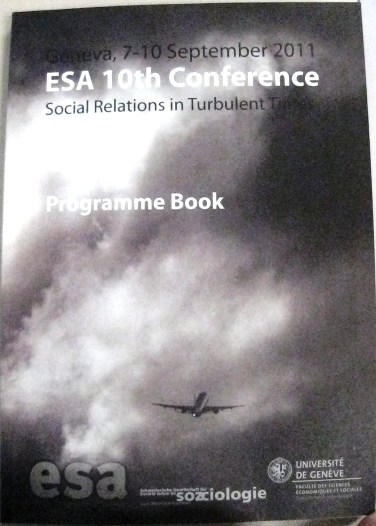
9月7日下午四点,开幕式在距日内瓦大学不远处的维多利亚大厅举行。大厅分上下三层,金碧辉煌,建于1891至1893年之间,为荣耀的维多利亚女王而建。
大会没有主席台,没有会幅,没有背板,只有一幅多媒体屏幕、讲台和主持人席位。校长、市长、大区区长均坐落场下侧席。
大会首先在瑞士民间乐器阿尔卑斯号角(Alphorn)的演奏中拉开序幕。曲目是2008年奥运会主题曲《我和你》,优美的旋律和美好的愿景引起与会代表内心的共鸣,引来阵阵掌声。想必是组织者对曲目的精心选择。
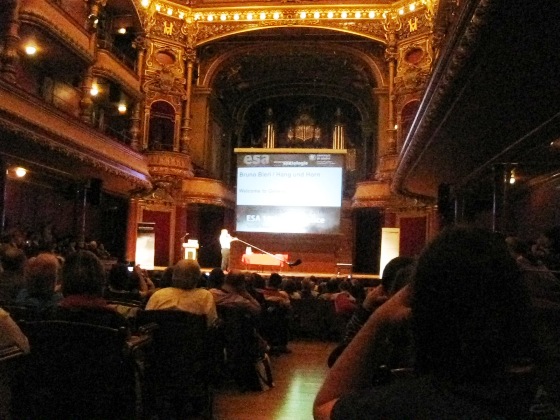
大会由日内瓦大学社会学系主任主持,日内瓦大学总务长、校长、日内瓦市长、日内瓦大区省长,欧洲国际社会学协会会长依次致辞。
欧洲国际社会学协会会长对整个会议概况做了介绍以及回顾了此前的各项工作。之后,参加2011—2013年欧洲社会学协会新一届理事会的22位候选人,依次向所有代表做自我介绍,以及未来的雄心。主席候选人二位,执委会候选人20位,选出主席1人,执委会成员10人。为差额选举。
闭幕式在9月10日上午11:00-12:30举行,并公布新当选的理事会主席及成员名单。
整个会议包括:4场Plenary Sessions, 12场Semi-Plenary Sessions,12场Special Sessions,从33个专题研究中安排611场小组会。9场作者与读者见面会。
大会为每位代表提供一个磁卡,那里含有本次大会所有的数据、信息。还给每个代表一个ID,可以免费上网。会场利用了大学的教室、公共大课堂,均备有多媒体设备。
二
9月8日上午大会主题发言,专题演讲均全面开始。
Plenary Session:都安排在晚上6:30-8:30这段时间
大会主题:Social Europe Under Pressure
三位欧洲学者在演讲中探讨了压力的类型、欧洲压力的特征,以及相互依存、冲突和控制的问题,比如来自瑞士的哲学家Erik VerKooyen说,“谁知道日内瓦是在天堂还是在地狱?!?没有路。他认为,现在是个人资本主义时代。剑桥大学John Urry ,认为人类正处于迷乱时代的一个峰值
他们的题目分别是:
The Generation Contract: a Social Model Under Pressure
What kind of pressure? What kind of Europe? Interdependency, Conflict and Control
Peaking and Social Turbulence
在另一单元Plenary Session,
主题:“Life Trajectories in Turbulent Times”,有三位学者演讲,题目分别是:
Globalization, Rising Uncertainty and the Vulnerable
Vulnerabilities of the Life Course, Vulnerabilities of Knowledge and “Sociological Imagination
Gender Inequality in the Life Course
在另一组专题演讲中,主题:Sociology for Turbulent Times:Views From Around the World, 有三位学者演讲,题目分别是:
Arab World in Turbulent Time: Who Are the Actors?
Citizenship, Hegemony, Authoritarianism
Indignation and Social Force
闭幕式的主题:The Future of Capitalism, 联合国教科文组织总干事Syvia Walby先生发表了主题演讲;伦敦城市大学John Solomos教授主讲了Thinking about Race and Racism in a Global Context.
在各个专题组的发言中Semi Plenary Session Program (共28个专业委员会),涉及12方面的主题:迷乱时代的个人与社会,价值,未来和劳动力市场“Migration: Ethic Relations, Racism and Biographic Perspectives on Migration”, “Threat and Risk to the Environment”,“Science Theory and Method”, “The Bologna Process and Sociology”, “欧洲人的福利和教育”, “金融危机:经济下滑(meltdown),劳动力市场和性别”,“作为社会学知识的一个问题:诚信危机”,“性别、不平等和危机:朝着持续发展和福利”,“青年人和不景气的世界”,“文化、艺术和宗教”,“传媒和消费”,“市民社会”。
Special Sessions:当代资本主义研究,法语讨论工作场,教育问题专题工作会议。
作者与读者的讨论共有九场(Meet the Author Sessions):
Session1/Book:”Social Vulnerability in Europe: The New Configuration of Social Risks” by MacMillan:London,2010
Session2/Book:“Qualitative Research ,Theory, Method and Practice” by Sage London,2010
Session3/Book: Unmasking Age: The Significance of Age for Social Research” by Polity Press,2011
Sessions4/Book: “Social Capital and Sport Governance in Europe,” by Taylor and Francis,2010.
Session5/Book: “Consumption Challenged: Food medialised in Medialised Everyday lives” by Ashgate,2011
Session6/Book: “Sociology of the European Union” by MacMillan,2011
Session7/Book: “Social Theory in the Twentieth Century and Beyond” By Polity,2010
Session8/Book: “Transnational Families: Ethnicities, Identities and Social Capital” by Boutledge,2010
Session9/Book: “Families Configuration: A Structure Approach to Family Diversity” by Ashgate,2010
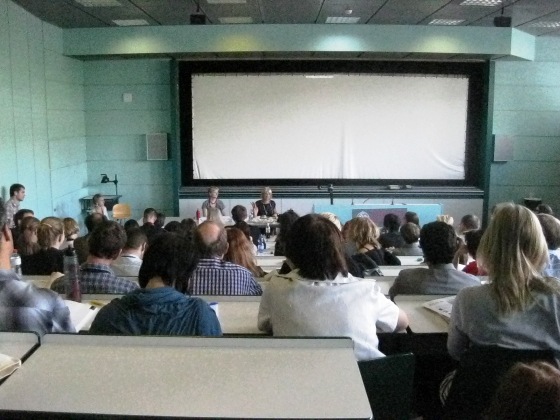
33个研究专业组, 包括33个讨论话题:
(1)Ageing in Europe
(2)Sociology of the Arts
(3)Biographical perspectives on European Societies
(4)Sociology of Children and Childhood.
(5)Sociology of consumption
(6)Critical political Economy
(7)Sociology of culture
(8)Disaster and Social Crisis
(9)Economic Sociology Research Network
(10)Sociology of Education
(11)Sociology of Emotion
(12)Environment and Society
(13)Families and Intimated lives
(14)Gender Relation in the labors Market and the welfare State
(15) Health and Healthcare in Europe in Challenge and Uncertain Times. (16)Industrial Relations, Labor Market, Institutions and Employment
(17) Communications Disruptions-European Perspectives on Global Challenges
(18)Sociology of Professions
(19)Qualitative Methods
(20)Sociology of Risk and Uncertainty
(21)Sexuality
(22)Sociology of Science and Technology
(23)Social Movements
(24)Sociology of Social policy and Social Welfare
(25)Southern European Societies
(26)Sociology of sports
(27)Social Theory
(28)Youth and Generation
(29)Ethnic Relations, Racism and Anti-Semitism
(30)Political Sociology
(31)Women’s and Gender Studies
(32)Sociology of Religion
(33)Sociology of Migration
21个研究组, 包括讨论题目有:
(1)Sociology of Disability
(2)Dynamics and Complexity of Minority Statuses in Plural Societies
(3)East and West in Europe: Two Decades of Transformations
(4)Maritimes Sociology
(5)Arts Culture and public Memory
(6)Socio-Anthropological Approaches to Transnational Migrations, Migrant Families and Migrant Practices
(7)Regional Conflicts
(8)Rethinking inheritance of Inequalities
(9)Sociology of Celebration
(9)Economic Elites in Turbulent Times
(10)The Tacit Knowing Approach
(11)Culture, Politics and Conflicts
(12)Methods for Comparative Research in Europe
(13)European, National and Regional Identities
(14)Bringing Lefebvre Sociology Back in urban Studies
(15)Sustainable City and Arts
(16)Evolution and Sociology
(17)Global and Transnational Sociology
(18)Russian Sociology in Time, Social Space and Transition
(19)The Relevance of Karl Marx’s Theory Today: Does It Exist?
另有部分参与者以提交论文的方式进行了交流。
我与刘耳合作的论文“中国城市化进程中市民与农民工冲突之辨:社会文化学的视角”,并在“Culture, Politics and Conflicts”专题小组中发言。
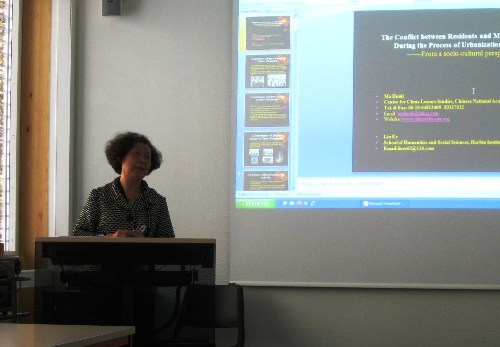
大会每天编发ESA News of The Day ,介绍前一天会议的主要内容,或重要思想观点。
比如第一天的ESA News of The Day 中有记者对多位学者的采访。“这里为什么是社会学家聚集的地方”?西班牙学者罗尔说:我在这里度假,我也更想知道社会发生了什么,我们能为个体和社会作出学术性的工作。葡萄牙学者配希罗说:我们可以从社会学中汲取更多的思考社会问题的方法,以及来自不同文化背景的共同兴趣。以色列学者恩尼特说:社会学给你更开阔的视野。
大会记者采访欧洲社会学协会的协调人圣?加伦大学(ST·Gallen University)托玛斯·伊贝尔,请他谈“迷乱时代的社会学”问题时,记者问,本次大会主题:迷乱时代的社会关系,我们能说社会学本身已进入了一个迷乱时代吗?或者说:它已经存在?伊贝尔说:不是社会学的迷乱时代,社会学是研究社会现象的,而是社会学正处于一个迷乱时代,这次大会的主题我们只所以选择“社会关系”问题,因为“社会关系”是社会学的核心问题。社会关系涉及行动(活动)、相互活动、交流沟通、情感因素等与他人、与制度、与体制、与物质发生联系。我们可以观察不同的社会领域,比如公共空间,私人空间、工作空间、家庭空间等等。我们只所以选择“时代”这个话题,的确,时代越来越迷乱,经济危机、金融危机,我们不得不考虑它对社会各个领域的影响。
记者又问:你是怎样体验“迷乱时代”的?答:通过媒体我观察到,无论是在阿拉伯世界,还是在法国南部,你都可以可以看见许多无业的青年,从经济和未来的角度看,我担忧我们将会突然发现我们的周围到处都有失业的人。当下法国出口产业崩溃(Export Industry Collapse),瑞士有更高的兑换率,这些正在改变我们的生活空间。他说:迷乱出现在所有地方。
三
欧洲社会学协会历时三天,2800篇论文涉及了社会学的方方面面,既有传统话语系统的声音,也有传统学术框架的倾履,表明了欧洲社会学就是在这种否定之否定中上升,并不断生成新思想、新观点、新方法。给我突出的印象是:
(一)、欧洲社会学秉承国际社会学协会宗旨:通过观察与科学方法描述、解释、预见社会以及社会变化,为决策者、管理者最终选择“应该怎么样”提供帮助。帮助人们掌握科学的社会知识,对社会结构、社会制度、社会关系等诸多方面采取理性与符合规律的认识。社会学家虽然不能直接参与社会决策,但可以用他们的智慧和远见卓识影响社会的进程。
(二)、欧洲社会学家具有强烈的危机意识,把握和预见社会问题的能力,他们在学术表达过程中客观、中立,不被各种政治派别所左右,不做政府或利益集团的应声虫。他们思想活跃,有各种形式的学术交流,有成熟、稳定的学术共同体。当然,目前的经济危机影响了各种资助经费的获得。接触到的一些代表都谈到了这个问题。甚至有文章专门讨论社会学如何摆脱金融危机的负面影响。这是迷乱时代社会学正面临的压力。
(三)、参加欧洲的学术会议,总会让我想起凡勃伦(Thorstein Veblen)提出的“‘准学术’与‘准艺术’的休闲方式,就其所产生的后果来说,都是美妙的、高超的”这句话。这是欧洲的学术传统,是欧洲人的休闲传统。欧洲的会议一般都安排在度假期,会议举办地都“风景如画”。许多代表都是“拖家带口”,或是夫妻同行。孩子们从小跟随家长接受学术氛围的熏陶,也游历大好河山。而学术本身也是休闲的一项内容,这个传统就是这样一代又一代传下来的。欧洲人文化资本也是这样积累的。
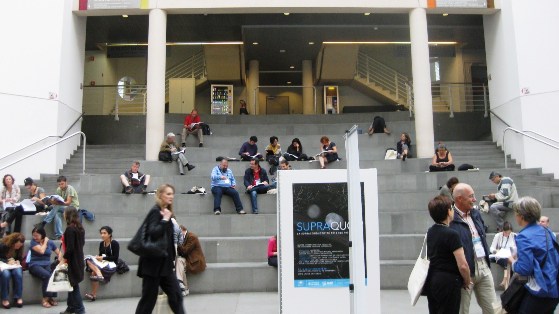
(四)、欧洲学者参与学术的热情,从一个侧面表明文化实力的强大,至今,社会学的理论创新、方法创新仍来源于欧美国家,因此,他们在世界上占据很强的话语权。从参会代表的地域分布看,欧洲学者占其83.98%,也就是说大约2500人是欧洲各国来的。欧洲大大小小43个国家,7.2亿人口,这个比例够高的。10.72%来自亚洲,从名册看,日本学者大概占据绝大多数,而中国学者寥寥无几,我在那里看到了来自中国少年儿童研究中心的一行五人,以“观察员”身份出席,没有提交论文。其它偶见的中国人也都是客居于它国。从这个意义上说,中国学者在国际舞台参与思想交流的人太少,文化实力差距太远,文化输出的能力太微弱。
(五)、瑞士以精准的制表业而闻名于世,日内瓦亦是一个世界会展之都。通过这次会议体验到了瑞士何以能成为一流的世界会展之都。首先,会议组织高度科技化,从发布信息、提交论文、论文发布、网上报到与注册、缴费、实时信息等等环节都利用互联网,而且高效、便利、易操作。3000人的大会纹丝不乱。其次,会议组织简单、简约、简朴,毫无铺张浪费。第三,学术会议,学术唱主角。学者之间人人平等——气氛平等、交流平等,协会的头头们都以普通学者的身份参与各个小组的讨论。第四,注册费收取合理,显然不以营利为目的。在大会为每一位代表提供的特制U盘里,不仅含有2800篇会议论文摘要,而且有欧洲社会学前沿的文章、讨论等等,让人感到“货真价实”和“物有所值”。
四
中国正在塑造文化形象,把发展文化作为未来的国家战略,这是新亮点和新起点。国家文化形象,不仅靠输出艺术演出、娱乐节目、动漫设计、影视传媒,在黄金地段打广告等具象化的文化产品,而且要靠输出思想、输出高水平的人文学者、输出最新的思想方法、输出对社会观察的最新视角等等来赢取国际同行的认可与信赖。我们关起门来唱得再热闹,也不过是自娱自乐。也不能光请进来,而走不出去。越走不出去,我们的视野越有限,也越自以为是和妄自尊大。
中国文化实力的提升,有赖于人文社科、哲学、艺术、宗教的全面繁荣。
台湾学友李明宗先生看过此文初稿后与我说,如果他翻译也许将turbulent译为“动荡”一词。查了《现代汉语词典》,“动荡”被如是解:“波浪起伏;(局势、情况)不稳定;不平静。”但是,当今的时代是“迷”:迷失方向和失去判断力,这是“乱”、“不稳定”、“不平静”的根源。因此,本文仍用“迷乱”一词。李明宗先生不仅就此与之讨论,而且发现文中多处谬误,并对文中的文字做了细致的修订,在此致以诚挚的谢意。
附:马惠娣刘耳论文(英文摘要)
The Conflict between Urban Residents and Migrant workers
During the Process of Urbanization in China
MA Huidi
Center for Leisure Studies
Chinese Academy of Arts
LIU Er
School of Humanities and Social Sciences
Harbin Institute of Technology
An Outline
A. Contributions of Migrant workers to China's Urbanization
According to statistics from government authorities, the number of migrant workers, who have become the mainstay for "Made in China" and an important component of China's industrial workers, has reached 240 million.? They make up 57.6% of the work force for the industrial sector, 52.5% of that for commerce and restaurant industry, 68.2% of that for manufacturing, and 79.8% of that for the construction industry.? It has been estimated that an average migrant worker is creating 25 thousand yuan of GDP a year, which means migrant workers as a whole is creating 5.7 trillion yuan of GDP a year.
B. The Status of Migrant workers' Life in the City
The following is a summary of relevant statistics from various sources:
- The average peasant worker earns 1747.87 yuan a month, or only 57.4% that earned by the average urban worker (3046.61 yuan).
- The percentages of migrant workers participating in endowment, medical, unemployment, work injury, and maternity insurances are 67.7%, 77.4%, 55.9%, 70.3% and 30.7%, respectively, which are 23.7%, 14.6%, 29.1%, 9.1%, and 30.8%, respectively, lower than the figures for workers who are urban residents.
- In terms of safety on the job, 36.5% migrant workers have to face working under high- or low-temperature conditions, 41.3% work in noise-polluted environments, 36% have work environments with hazards of mechanical failure that can easily lead to physical injury, and 34.7% work in environments with dust pollution.
- In terms of work hours, only 29% work 6-8 hours, while 44.4% work 8-10 hours, and 20.4% work more than 10 hours a day.
- they tend to have poor living conditions, with only 19% having housing with heating, toilet, bathroom, and kitchen, while more than 80% peasant-worker households lack these facilities.
- Especially those doing hard work in the service sector, hardly have any leisure time, for they often have to go to work before dawn and come home after the moon is up, and sometimes having insufficient time even just to meet the need for rest as a biological being.
C. Major Areas of Conflict between Residents and Migrant workers
1) Wage
Among migrant workers legally entitled to overtime compensation, 54% never get paid, and 20% only occasionally get paid for overtime. 76% of work on holidays without being paid according to wage levels stipulated by the national government.
2) Education for Their Children
Education for one's children is among the central problems for those who come from rural areas to work in the city. They are close to 20 million children at ages for mandatory education who come to the city with their parents, but close to 200 thousands of these children have either been unable to attend a school or have dropped out.? In August this year, the municipal government suddenly gave out an order to have 24 schools for children of migrant workers demolished, bringing the prospect of tens of thousands of children losing their opportunity for education.
3) Impoverished Cultural and Spiritual Life
Migrant workers hardly have any time for leisure, not to mention any cultural activities or aesthetic pursuits.
D. Major Manifestations of the Conflict
1) Discrimination: migrant workers are often driven around
2) Lack of welfare: no social security, no medical insurance, and no personal insurance
3) Taking revenge on the society: migrant workers are involved in many criminal cases, often acting out of hatred for the rich man and for government officials
E. Main Causes for the Conflict
1) Lack of institutional guarantees for a decent and dignified life
2) Lack of policies providing sufficient life space
3) Lack of institutional guarantees for political participation
4) Lack of institutional guarantees for personal development
5) Lack of humanistic concerns in the process of urbanization
6) Lack of patterns of rural space and culture
7) Lack of respection derisively as “waidi ren,” or outsiders, or second-class citizens.
8) Lack of hukou system (the mean to obtain an urban residence permit, called a hukou), as it is called, has created a two-tiered population in many Chinese cities: those with legal residency and those without.
Conclusion
Though urbanization is a central tenet of the China government the latest five-year economic plan for the country just released, the 250 million rural migrants who are expected to move to cities in the next 15 years could become a source of social unrest unless the ID system is reformed. Having that many second-class citizens in Chinese cities is dangerous.
The conflict between resident and migrant also reflect the reality society in china is unbalance and unharmonious on the city and rural, culture and economy, tradition and contemporary and belief and utilitarian
In fact, GDP rapid growth Numbers and more a place where rise up modern cities could not conceal already social problems. Although, the government has been aware of the seriousness of the problems, but the corruption, “face projects” mean gaudy, officials make a shows and Rigid system were popular wherever in china,so the problem is difficult to solve.

